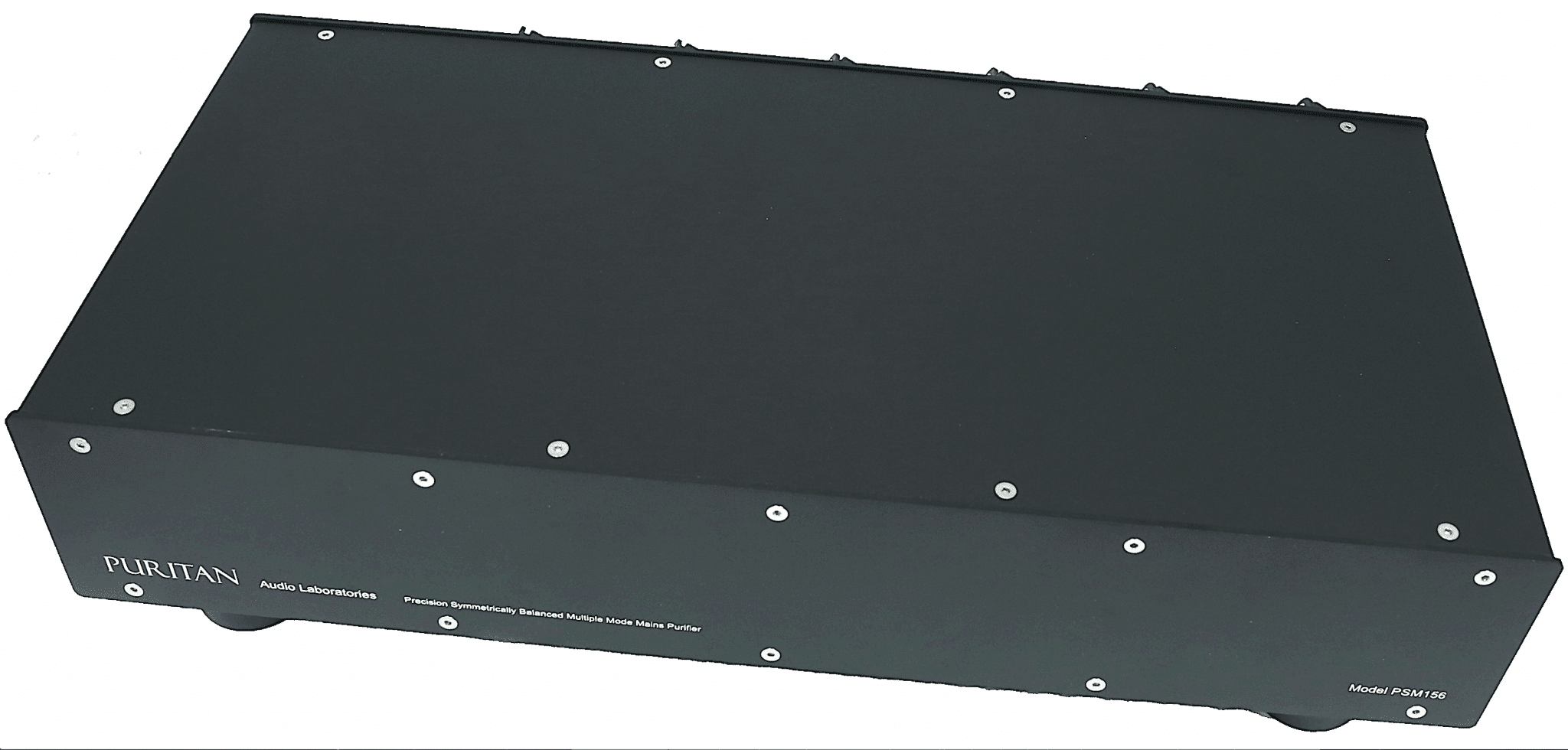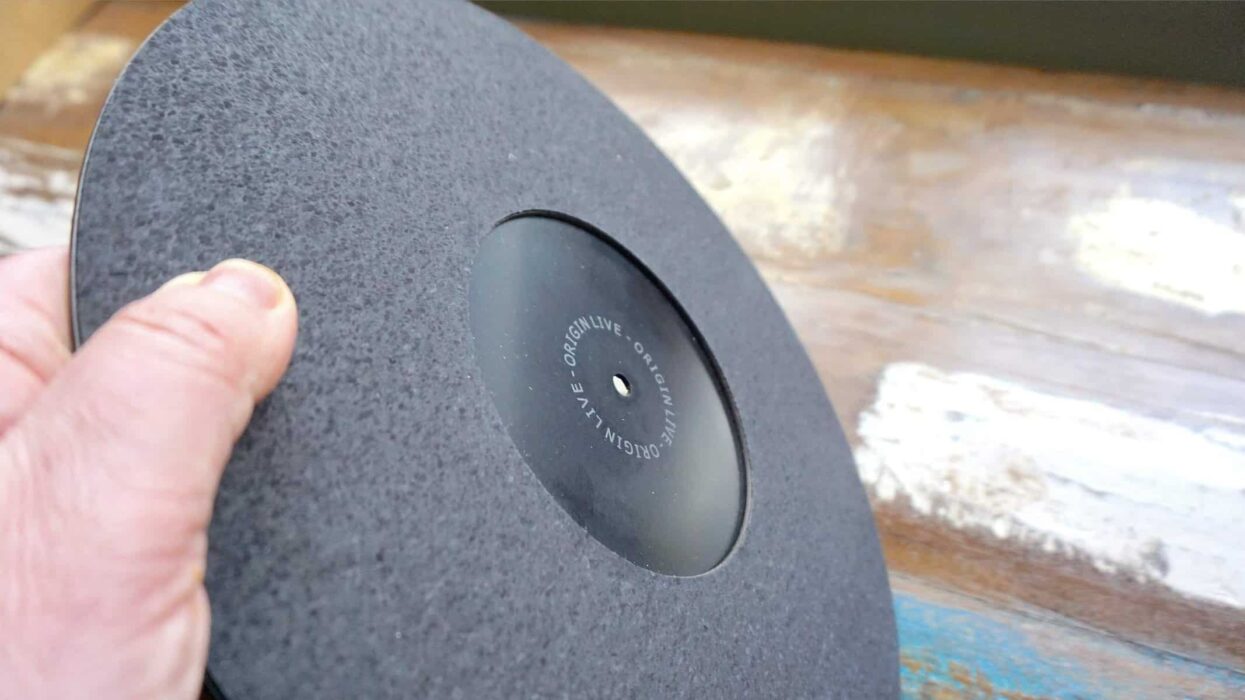The Article
Puritan PSM 156: cleansing and purifying your mains electrical supplies
30th July 2017

Looking to clean up a gamut of noise around his hi-fi via mains conditioning, Paul Rigby reviews Puritan’s new flagship product, the PSM 156
Oxfordshire-based Puritan design and manufacture products that cleanse and purify mains electrical supplies. The company likes to emphasise that it purifies while keeping the power and also the dynamics present in the supply. It tends to develop products that purify the electrical supply in stages rather than in one fell swoop. Hence, Puritan likes to boast that its AC waveforms are clean but, “…also allows the hi-fi chain to maintain its sound quality.”
The last flagship product from Puritan, the PSM 136, arrived with six 8 Amp outputs. This unit wasn’t helped by protection from the 13 Amp plug so the company, at that time, decided to fuse each and every output. This is a consumer box, after all and you’re bound to get someone looking to plug in a living room heater or some such. Not recommended but it has, according to the company, happened. Tests showed that, in sonic terms, this individual fusing didn’t detract in sonic terms. Many of Puritan’s users begged to disagree, though. Ever the listening company, Puritan decided to act.
What it has done is to produce a new unit that features the same degree of filtration and cleansing but offer six outputs that can handle 15 Amps. This means that they do not require individual fusing and depend on the mains plug instead. The new unit, which sits in the Studio Master range, is the PSM 156.
Designer and Puritan boss, Mike Lester commented, “So the PSM156 aim was to eliminate the need for overcurrent protection in the box with the fuse in the plug of the power lead providing the overall safety (Schuko, Nema, etc. versions have a single internal 15A fuse as these plugs are unfused, this fuse is not present in UK versions). To achieve this each independently filtered output needed to be rated at 15A. This is achieved with chunkier heavier windings. As increasing the current potential with heavier wire and less windings reduces the attenuation of unwanted frequencies this is compensated by increasing the number of stages to provide superior removal of unwanted frequencies with unfettered current delivery. This route of increasing the number of multiple cumulative stages of purification from 39 in the PSM136 to 52 in the PSM156 has given further gains in performance.”
While testing the unit, I also grabbed a batch of Puritan’s mains cables to hook up to my system.
I began with my CD transport and DAC on the premise that there’s a whole heap of noise floating around this area. I initially hooked both the transport and DAC to basic mains cables. The type you’d find attached to a kitchen kettle and then to a basic power block, the basic white plastic type bought at a hardware store. Apart from the mains, I placed each on quality hi-fi supports from Atacama and further – rather expensive – isolation products from HRS. Hence, the in terms of potential sound quality issues, the mains connections were the principle variable here.
SOUND QUALITY
As I was getting ready to test the Puritan, I listened to my hi-fi connected to a basic, High St power block as a form of base level reference. A truly horrible item that actually adds noise to the system. There is no effort to remove any noise here, it’s job is to put the kettle on, nothing more than that. After listening to the dross it was spouting, I prepared the Puritan by plugging it into an adjoining wall socket. No components of my hi-fi were attached to it, at this point. The Puritan was connected to the wall socket ’empty’, as it where. I was playing Depeche Mode’s Enjoy The Silence at the time through the High St socket.
Once the Puritan was ‘in the wall’, as it where, I stopped and paused. I couldn’t quite believe what I was hearing and stopped in my tracks when the music played again. There was a distinct difference in sound quality. It seemed that the Puritan’s mere presence within the mains was having an effect because it started to clean up the mains, adding a slice of focus and reducing noise right there and then. I fact, I could hear a low level bass rhythm for the first time. OK, it took a bit of searching out with the ears. It wasn’t absolutely obvious but it was there. This entire happenstance was just that, a pure accident on my terms. I wasn’t expecting it (although I know of expensive Vertex AQ kit designed to do just that, it will have an effect by merely being part of the local mains system). For the Puritan to have such a positive – and wholly unadvertised effect I might add – effect was startling, though. It also means that, if you run out of sockets, any other kit plugged into the local mains circuits will benefit from a measure of cleansing even if not directly attached to the Puritan.
A good, if rather unexpected, start then! I then plugged my CD transport into the Puritan along with a set of Tellurium Q cabling and my Nordost mains block and found an immediate drop in offensive noise frequencies. The result was a far smoother midrange which affected all areas of the sound spectrum. Vocals offered an expressive element, adding a texture to the voice while electric guitar string plucking no longer suffered from an offensive, bright upper midrange. Drums, meanwhile, provided a greater rhythmic capacity. They rolled with ease as the beat flowed instead of stumbled. Imagine walking over cut glass and then (after a spell in A&E) doing the same on a plush carpet. That imagined difference was how the drums sounded to me as a ‘before’ and ‘after’. The harshness in some elements of the soundstage remained but the sonics were much improved.
I then plugged in the DAC using the same superior cabling and the noise reduced so much that the gain had to be raised two notches on my pre-amp to achieve the same level. Doing so increased the general level of detail resident in the soundstage. This meant that the vocal harmonies offered greater information, becoming a collection of voices instead of an amorphous blob. Bass was stronger and offered a effective mass while the lower lying synth runs, rather hidden in the mix thus far, made a more significant appearance, as did the ride cymbal.
I then plugged my vinyl chain (phono and pre-amps) into the reference Nordost power block with Tellurium Q power cable and played David Gray’s Please Forgive Me.
All kinds of changes occurred when the Puritan entered the frame, the drums emerged from a silent background giving the complex rhythmic drumming a distinct and penetrating effect with oodles of character and oragnic resonance.
Speaking of which, Gray’s voice, such a grainy instrument on its own, benefitted with a reduction of noise, giving his delivery more air and space to manoeuvre. The grains in his voice were almost seperated. You could hear into his voice. That is, the tiny intonations as he sang each word held more information and clarity.
There was also more air and space between the synth and piano, allowing each more elbow room to provide a greater tonal accuracy as the smoother midrange performance provided more ease and flow.
I then attached the supplied power cables to the phono amplifier and pre-amplifier and back to the Puritan. The result was a further reduction in noise and a richer, more mature sound. Sonic strident spots were calmed, clarity was infused into the soundstage while further noise reductions allowed the subtle aspects of the music to be brought forth. Once the gamut of tiny details were visible to the ear, the song itself provided a fuller and busier experience.
CONCLUSION
I was impressed by two things from the Puritan. The decrease in the amount of noise allowed me to hear more information, enhancing all frequencies over the soundstage. The improvement in clarity and focus also helped the music to flow and eradicated harmful frequencies that sometimes demanded hands over the ears. More than that, though, while noise was reduced, the dynamics were never reduced. Hence, the music retained its life and vigour. I never thought that the ‘treated’ music ever sounded dull which is a great tribute to the design. The Puritan PSM156 is an ideal method to treat mains noise and distortive elements, letting you hear more music which is, after all, the point of hi-fi.
PURITAN PSM156 STUDIO MASTER MAINS PURIFIER
Prices:
PSM156 is £1,450 (including the Dual Dissipative connecting lead from the unit to the wall)
1.0m mains lead is £75, 1.5m is £85, 2.0m is £100, 4.0m is £130. Other lengths on request.
Tel: 01491 680444
GOOD: low noise, dynamic sonics,
BAD: nothing at the price
RATING: 8
REFERENCE
Origin Live Sovereign turntable
Origin Live Enterprise 12” arm
Transfiguration Proteus cartridge
Leema Essentials CD player
Benchmark DAC2 HGC
Icon Audio PS3 phonostage
Aesthetix Calypso pre-amp
Icon Audio MB845 Mk.II momoblock power amplifiers
Quad ESL-57 speakers [One Thing modded]
Vertex AQ cabling
Tellurium Q Black speaker cables
Harmonic Resolution Systems Noise Reduction Components
All vinyl was cleaned using an Audio Desk’s Ultrasonic Pro Vinyl Cleaner
Nordost Quantum QBase QB6 power block








Dear Paul.
I’ve been nobbled by Mike Lester at one or two Hi-Fi shows recently and my interest has been growing in the PSM 156 or 136. I’ve read your glowing reviews about these items but one particular aspect leaves me unconvinced.
I’ve been ‘doing’ Hi-Fi for many decades, both off the shelf and DIY. The system I have is of a very high standard including many Russ Andrews mains, speaker and interconnect cables.
Your review compares the units to a ‘basic, High St power block’ with suppliers’ cheap mains cables. In my experience, it does not take much at all to improve on these cheap cables and, not surprisingly, your review says the Puritan units do so.
However, what I would like to know is how a Puritan unit in a system compares to a good set of mains cables such as those I already have.
Whilst I accept that it is difficult to make this sort of comparison because there are so many types to choose from, at present your review gives me no guidance at all.
I wonder if you could comment on how good these Puritan units really are compared to decent Hi-Fi cables please?
Thanks you in anticipation.
Kind regards
Andy
You’re quite right to point out this matter which results in my own inadequacies, I’m afraid. I made the mistake of not alerting the reader early enough when I changed to superior cabling, etc. I did state this later in the Sound Tests: “I then plugged my vinyl chain (phono and pre-amps) into the reference Nordost power block with Tellurium Q power cable and played David Gray‚Äôs Please Forgive Me.”
Nevertheless, I need to tweak the editorial a bit because I obviously got carried away and delayed that text 🙂 If you also look at the base of the review at the reference section, that will give you an idea of the higher end cabling, etc, that I also utilised after the basic stuff was covered. My apologies.
Hello Paul ,
This review is very interesting and timely! After more than 25 years of hifi passion, I am recomposing a hifi system by starting from almost zero! On the pure stereo side, for the amp, I chose a tube amp from the Greek manufacturer Tsakiridis, the Aeolos Ultra KT150, for the digital source I kept my old Rega Planet MK1 and my streamer Linn Majik DS, but I add the DAC Atoll DAC 300 which will also be used with my MacBookPro and Audirvana! For the Analog part I have a Rega P3 / 24 very widely modify both in terms of platter, subplatter, chassis as well as the tonearm which will receive a Hana SL cell Aurorasound Vida Prima phono preamplifier! the speakers will be AtlantisLab AT16! So much for the hi-fi part! I also have another passion, homecinema and I’m going on an Anthem MRX 1120 amp, Blu-ray player not yet defined! My question is, Do you think that the Puritan PS156 will be able to accommodate the tube amplifier and the audio / video amplifier without compaction of Dynamique … On the other hand, can we plug into the same socket of the PS156, the internet box and my SILENT ANGEL Bonn N8 ethernet switch, instead of buying a linear power supply for each of them? What do you think ? Thank you very much !
Best Regards
Pascal
Hi Pascal – I think you should be fine but, to make sure, give the company a call (via the contacts at the end of this piece). They’re a small outfit and very helpful. Ask for Mike, say I sent you and you’ll be looked after 🙂
Ok Paul , Thank you Very much ! üëçüèΩ
Different is not right like many reviews they use a cheap power strip then say this $1,000 unit sounds better, jeez no kidding, Really? This unit is no different than any other “balanced Power conditioner” they all do what thing strip the music of the body and make the presentation sound cleaner, I’ve owned many and sold them all, the only units that do no damage and improve the sound from the deepest bass on up is the PS Audio Regnorators. Because it sounds different does not make it right, right is when everything is improved from the low’s to the highs and vocals gain body, chest, and weight like a real human being talking or singing in front of you.